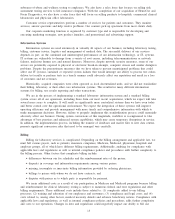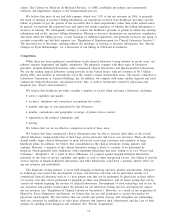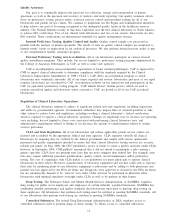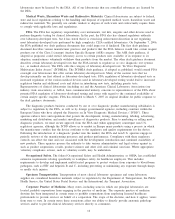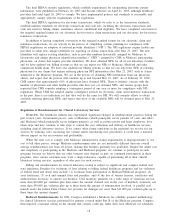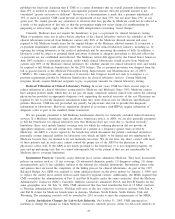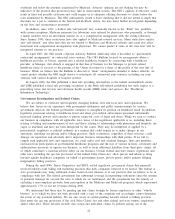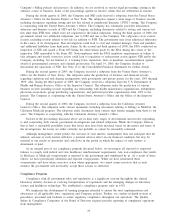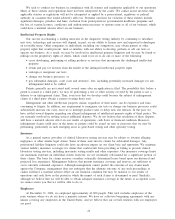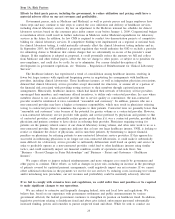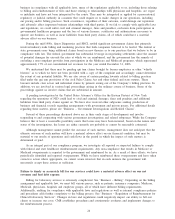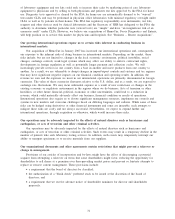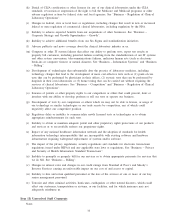Quest Diagnostics 2006 Annual Report Download - page 44
Download and view the complete annual report
Please find page 44 of the 2006 Quest Diagnostics annual report below. You can navigate through the pages in the report by either clicking on the pages listed below, or by using the keyword search tool below to find specific information within the annual report.Company’s billing policies and practices. In addition, we are involved in various legal proceedings arising in the
ordinary course of business. Some of the proceedings against us involve claims that are substantial in amount.
During the fourth quarter of 2004, the Company and NID each received a subpoena from the United States
Attorney’s Office for the Eastern District of New York. The subpoenas request a wide range of business records,
including documents regarding testing and test kits related to parathyroid hormone (“PTH”) testing. The Company
is cooperating with the United States Attorney’s Office. The Company has voluntarily provided information,
witnesses and business records of NID and the Company, including documents related to testing and various test
kits other than PTH tests, which were not requested in the initial subpoenas. During the third quarter of 2006, the
government issued two additional subpoenas, one to NID and one to the Company. The subpoenas cover various
records, including records related to test kits in addition to PTH. The government may issue additional subpoenas
in the course of its investigation. This investigation could lead to civil and criminal damages, fines and penalties
and additional liabilities from third party claims. In the second and third quarters of 2005, the FDA conducted an
inspection of NID and issued a Form 483 listing the observations made by the FDA during the course of the
inspection. NID responded to the Form 483. Noncompliance with the FDA regulatory requirements or failure to
take adequate and timely corrective action could lead to regulatory or enforcement action against NID and/or the
Company, including, but not limited to, a warning letter, injunction, fines or penalties, recommendation against
award of governmental contracts and criminal prosecution. On April 19, 2006, the Company decided to
discontinue the operations of NID. See Note 15 to the Consolidated Financial Statements for further details.
During the second quarter of 2005, the Company received a subpoena from the United States Attorney’s
Office for the District of New Jersey. The subpoena seeks the production of business and financial records
regarding capitation and risk sharing arrangements with government and private payers for the years 1993 through
1999. Also, during the third quarter of 2005, the Company received a subpoena from the U.S. Department of
Health and Human Services, Office of the Inspector General. The subpoena seeks the production of various
business records including records regarding our relationship with health maintenance organizations, independent
physician associations, group purchasing organizations, and preferred provider organizations from 1995 to the
present. The Company is cooperating with the United States Attorney’s Office and the Office of the Inspector
General.
During the second quarter of 2006, the Company received a subpoena from the California Attorney
General’s Office. The subpoena seeks various documents including documents relating to billings to MediCal, the
California Medicaid program. The subpoena seeks documents from various time frames ranging from three to ten
years. The Company is cooperating with the California Attorney General’s Office.
Several of the proceedings discussed above are in their early stages of development and involve responding
to and cooperating with various government investigations and related subpoenas. While the Company believes
that at least a reasonable possibility exists that losses may have been incurred, based on the nature and status of
the investigations, the losses are either currently not probable or cannot be reasonably estimated.
Although management cannot predict the outcome of such matters, management does not anticipate that the
ultimate outcome of such matters will have a material adverse effect on our financial condition, but may be
material to our results of operations and cash flows in the period in which the impact of such matters is
determined or paid.
As an integral part of our compliance program discussed below, we investigate all reported or suspected
failures to comply with federal and state healthcare reimbursement requirements. Any non-compliance that results
in Medicare or Medicaid overpayments is reported to the government and reimbursed by us. As a result of these
efforts, we have periodically identified and reported overpayments. While we have reimbursed these
overpayments and have taken corrective action where appropriate, we cannot assure investors that in each
instance the government will necessarily accept these actions as sufficient.
Compliance Program
Compliance with all government rules and regulations is a significant concern throughout the clinical
laboratory industry because of evolving interpretations of regulations and the emerging changes in laboratory
science and healthcare technology. We established a compliance program early in 1993.
We emphasize the development of training programs intended to ensure the strict implementation and
observance of all applicable laws, regulations and Company policies. Further, we conduct in-depth reviews of
procedures, personnel and facilities to assure regulatory compliance throughout our operations. The Quality,
Safety & Compliance Committee of the Board of Directors requires periodic reporting of compliance operations
from management.
23


